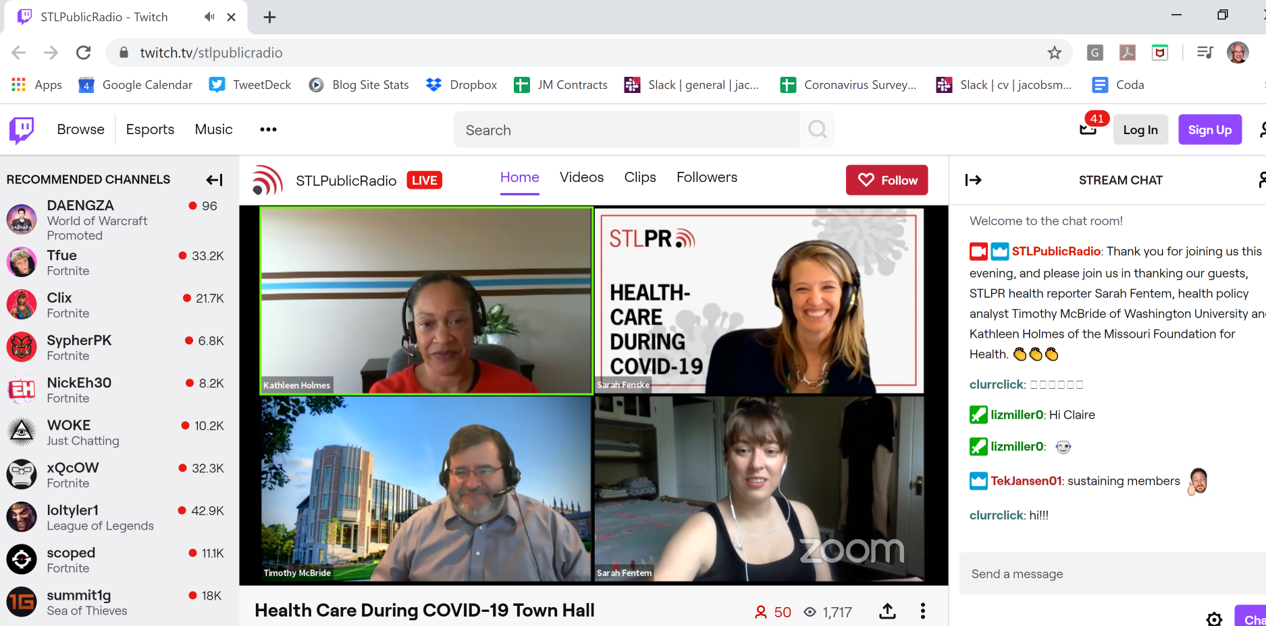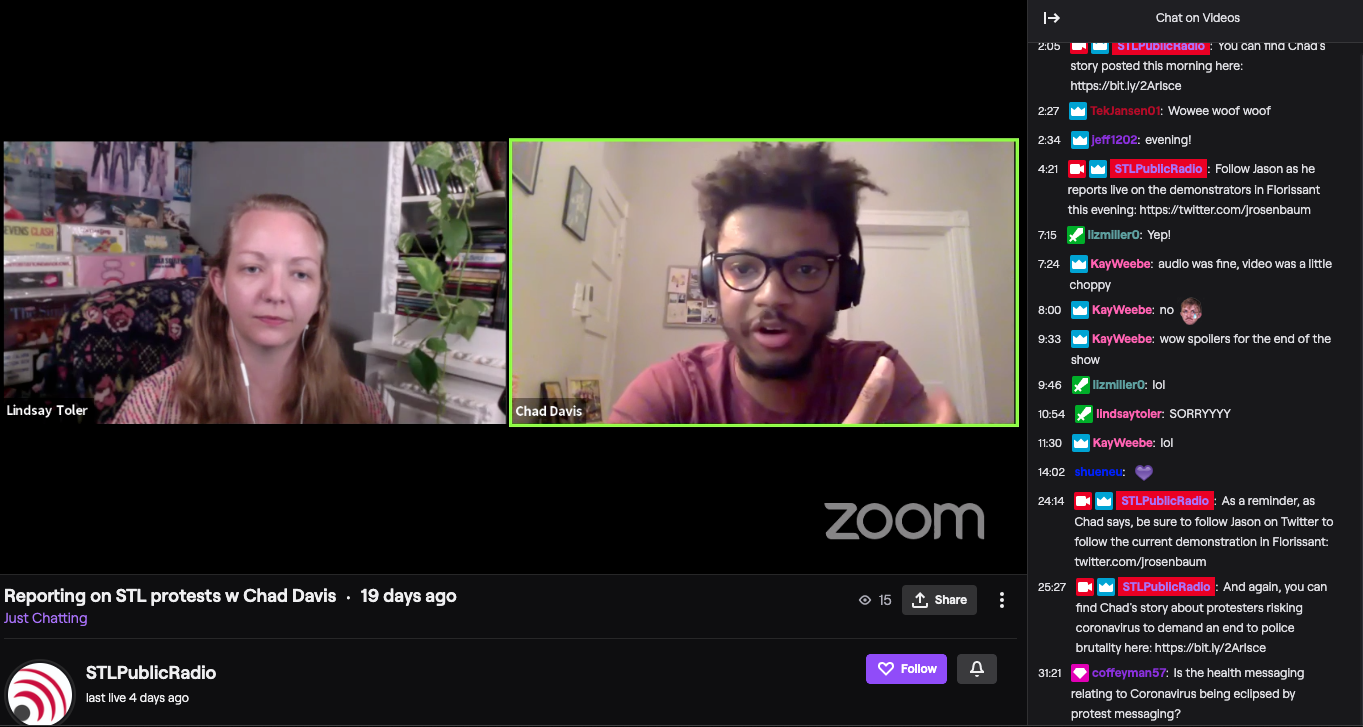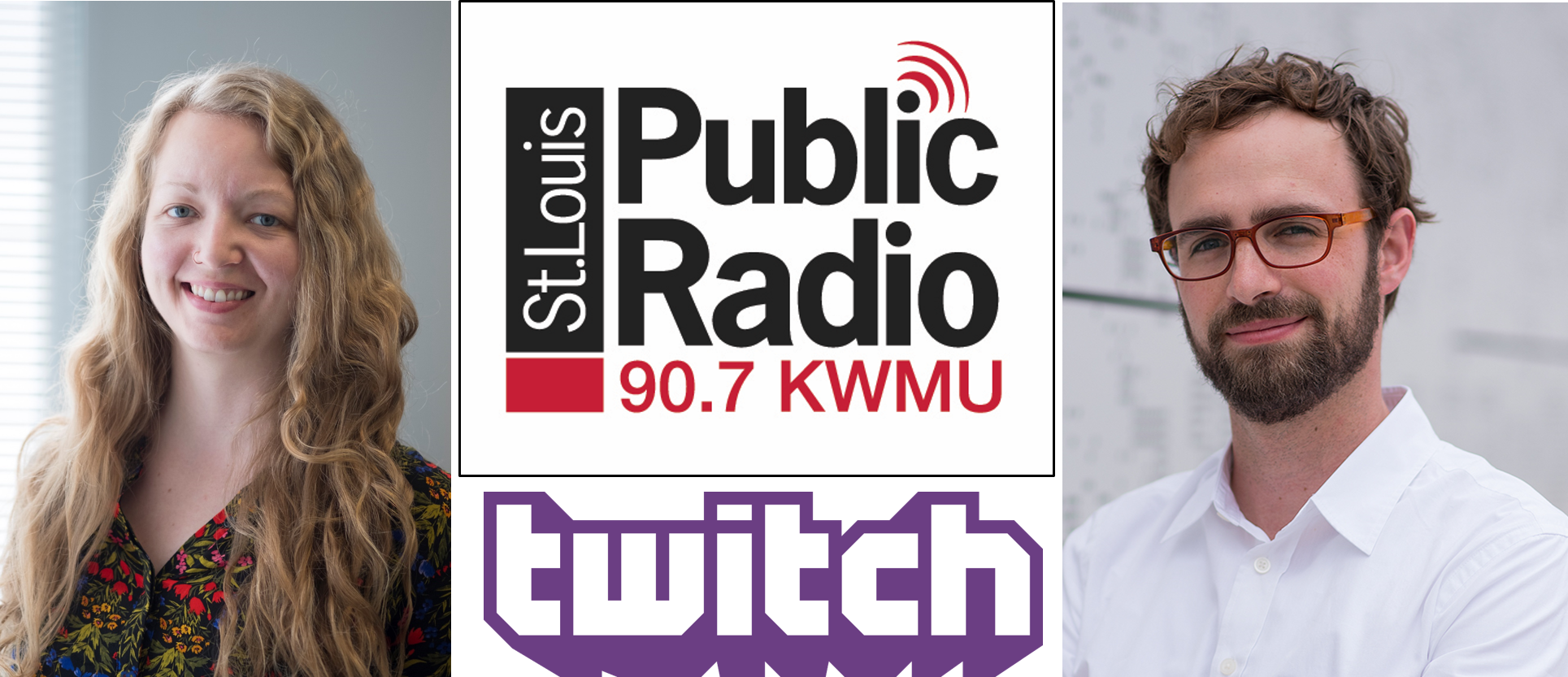
Regular JacoBLOG readers have no doubt read about the Twitch platform, originally a virtual world for gamers than has branched out into other media realms, including radio. If you have teenagers, you’ve probably see them on Twitch, chatting away with friends and other like-minded peers.
Twitch is an interactive community, heavily inhabited by Gen Z, but is now being pressure-tested by other media players. A couple of fun facts about Twitch:
It’s not a niche platform. More than 37 million U.S. consumers visit Twitch at least monthly. (Since COVID, those numbers have no doubt moved even higher as people try to relieve the boredom.)
Twitch requires very little. It doesn’t require registration, if you just want to lurk around. That makes it convenient for anyone to come and ago, with minimal distractions and barriers to entry.
And another fun fact: Twitch is owned by Amazon who bought the platform exactly nine years ago for a paltry $975 million.
Radio has discovered Twitch. A number of personalities and shows have set up their own channels on Twitch, including Bubba the Love Sponge and Sports Hub’s Toucher & Rich. More and more media franchises are exploring the ecosystem, including a well-established traditional media player – the Washington Post.
Obviously part of the thinking for the print and radio media is the novel video livestreaming nature of Twitch. But there’s another motivation here, too – a connection to a younger audience that may not be engaged with broadcast.
For all those reasons, I keep an eye on Twitch – it’s a fascinating place to hang out. And a few weeks back, I was spending time on Twitter, and saw a tweet announcing a St. Louis Public Radio town meeting about health care…livestreaming on Twitch. I did a double-take when I visited their channel:

Now, it’s possible other public radio News/Talk stations have discovered Twitch – it’s a topic I brought up last year at the Public Radio Program Directors Content Conference. But most media outlets either don’t know much about the platform or are sitting on the sidelines, waiting for someone else to break ground.
To find out more about why a high-profile public radio station has taken the dive – particularly in the middle of the pandemic – I reached out to their GM, Tim Eby. He told me the force behind his station’s Twitch strategy is two members of his team, Lindsay Toler, Digital Engagement Producer, and Brian Heffernan, Editor of Digital and Special Projects.
I caught up with Lindsay and Brian for a deep dive about livestreaming news and public affairs shows, how their Twitch adventure is working out, and why they launched it in the first place.
Fred: How long has St. Louis Public Radio been using the Twitch platform? Is the goal to reach current listeners, new audiences, or something else?
Lindsay: Our first Twitch stream was on April 27. I’d been doing an hour-long news show on Facebook Live before that for a couple of weeks.
My goal is to connect with new audiences who expected a new way to learn about all the craziness going on. I felt like I needed a new way to talk to our current audience. Coronavirus-spurred shutdowns meant that they were no longer listening to us during their morning commute or scrolling our Twitter feed when they were bored with work.
All my old ways of connecting with people were upended. And the news was so confusing and ever-changing. Thirty seconds on the radio wasn’t enough time to explain, and we couldn’t churn content out fast enough. I needed a place to have a conversational discussion with my current audience and tell them what was happening behind the scenes in the newsroom.
Fred: How are you utilizing the platform – mostly for news stories or are you using it for other applications?
Lindsay: We mostly use it for news, but it’s also becoming our default events platform in a social distancing world. We do weekly local music shows, which often bring in more numbers than the news show. The #1 thing we want to do on Twitch is talk about the news. That said, I do think playing some Twitch Sings or chess on the stream would be a fun way to give people a look into our newsroom.

Brian: There’s also an element to everything we do on Twitch which aims to provide some transparency about how journalism is made. The pandemic has, in some ways, forced the conversational way we talk about the news from our kitchen tables, home offices, etc. Early on, we talked a lot about how our reporters are doing their jobs during this unprecedented time.
We also discuss how we know the facts we’re reporting and the limitations of what we know — a recent conversation on the stream with our data journalist about the trends of new coronavirus cases and deaths comes to mind. It’s a lesson in media literacy.
Fred: How do you feel Twitch compares with Facebook Live which obviously has more users?
Lindsay: We started on Facebook Live because it’s a platform people are already familiar with. Our audience already has a relationship with us on Facebook, and it’s likely they have the app on their phones. I like the notification Facebook gives users when we go live. There are plenty of reasons to livestream on Facebook, YouTube or even Periscope over Twitch depending on your purpose.
I started on Facebook because I was afraid my audience wouldn’t follow me to a new platform. But then I started seeing the problems with Facebook: People don’t want to use the platform because of privacy issues. The notifications work against you when they distract your audience. There are links and ads around your content that you can’t control. Plus, the lag time means there is a delay in real-time reaction to the chat (around 20 seconds).
YouTube also has downsides: The algorithm takes users to places that are downright scary, and it also has a less-than-robust chat feature.
What I love about Twitch is that it’s dedicated to live content, which makes it feel much different than YouTube. There’s a thrill of the hunt that reminds me of channel surfing before the days of Netflix. Plus it’s intuitive for new users; once they click the link, they get the full experience without logging in. That makes it easier for me to convert my current audience to the new platform.
Brian – Also, I think Periscope showed during the months of protests in 2014 after police killed Michael Brown that people are willing to click a link to watch live video. Certainly, there’s more urgency to a video like that than, say, a live stream of us chatting about the news, but the concept is still similar. That Twitch allows viewers to watch the stream without first making an account is an essential feature for us.
Fred: How has response been? Are you seeing usage growth and response?
Lindsay: I am really encouraged by how easy it has been to build a stable base of loyal users. People got what we were trying to do, and that made me feel more confident in the whole experiment. I have noticed a slowing in our growth, and I think it has to do with the economy reopening.
After our STLPR House Show last week, I went out to take a walk and saw the bar down the street had a full patio and a live band. I can’t compete with the IRL (in real life) experience over livestream! But I can keep making content for people who don’t feel safe leaving their homes yet.
Fred: Are people using the chat box to communicate with your host, ask questions, or chat with each other?
Lindsay: Oh yes, to the host, to each other. Sometimes people even ghost chat, or post to the chat when they watch the stream later on demand. The chat is the heart of the stream. It’s how you know the experience is live and not pre-taped. (This is what, in my own personal opinion, Joe Biden gets wrong in his campaign live streams. Without a robust interaction with the chat, audiences lose trust in the streamer.)
Fred: How does Twitch fit in with or complement other distribution platforms STLPR is using (smart speakers, streaming, etc.)?
Lindsay: It’s part of our evangelistic strategy to meet our audience wherever they already are. The “doom scroll” is so unhealthy, even if you’re reading veritable news sites, and I think our livestream content gives our audience the emotional space and support to examine bad news thoughtfully. We don’t have to worry about time or word restrictions on Twitch. We just talk about what’s on people’s minds.
Brian: I think with Twitch there’s also a big similarity to our other big distribution platform: FM radio. The largest age demographic blocks of those two platforms are certainly different, but there’s that similar live quality to them both. We want to be there for our audience both when they’re seeking that live experience (FM radio, live digital streams, Twitch) as well as on-demand programming (podcasting, NPR One, Twitch VODs).

Fred: Do you have longer term goals for Twitch and STLPR?
Lindsay: I want to have a full channel where each reporter has their own weekly show and we stream karaoke at night. People think I’m joking when I say that, but I’m not. I also want to have more concerts and content for teens and kids. Parents are working overtime as teachers and camp counselors, and I’d like to help them as much as possible. I’d like our newscasters and on-air talent to livestream themselves from the studio every time they go on air, especially for newscasts. And I think there are a lot of opportunities here for our daily talk show to connect with its audience over livestream.
Brian – A local public radio station can dream, right? In the near term, we’re working on developing the brands of our different types of streams: discussions about the news of the day, live concerts, etc.
Fred: You may be one of the only public radio stations in the U.S. using Twitch. What would you say to other stations considering using it (or competing platforms)?
Lindsay: Please join us! Think of it this way: Twitch is to radio as YouTube is to podcasts. The No. 1 thing you need to have a successful stream is a host who can talk about the news for an hour. And guess what, you probably employ a whole newsroom of people who can do that!
Fred: What have you learned from your Twitch experience about your content, your distribution, and your audience?
Lindsay: There is a section of my audience that wants to know more than the news; they want to know about the editorial judgments that went into producing the news. These are hyper-literate digital natives who know to treat all online information with a healthy amount of skepticism. They expect to be able to challenge and question sources of information, including journalism outlets.
This group seems just as interested in learning about media literacy as the folks who signed up for the station’s mini-journalism school program last year, although that was a much older and less online audience. I think promoting and teaching media literacy is the most important work we can do right now, and Twitch is an easy platform to do it on.
Fred: Anything else you’d like to share?
Lindsay: Keep your eye on this news with Mixer and Facebook Gaming. I think Facebook is dead wrong to bet its livestream success will hinge on gaming when it’s so much more than that. Gaming is just one of the many activities you can do for many hours while a worldwide audience watches live.
I also like to watch my favorite streamers talk, go shopping, dance, make a meal, clean their homes, take a walk, ride a bike, sit in a cafe or take a nap. Twitch understands that, and streamers can effortlessly switch activity categories while live. By focusing exclusively on gaming, Facebook is giving away that it’s an interloper to this platform, and Gen Z won’t be fooled.
Brian – And if you have any ideas about Twitch you want to share with us, hop in the chat and hit us up!
This year, the PRPD Conference – “Let’s Go Live” – has gone virtual. Info and registration here.
Jacobs Media’s Seth Resler will be hosting a webinar – “Livestreaming Video 101” – featuring UK-based journalist and author, Peter Stewart. It’s set for Thursday, 7/16 at 2pm. Info and registration here.
- Media And Technology In 2025: Believe It Or Not! - April 18, 2025
- In Radio, You Just Never Know - April 17, 2025
- The Secret To Making A Great Podcast (And Great Radio) - April 16, 2025




Westwood One brought Twitch to us 3 years ago for our fantasy platform. It is an exciting, still untapped playground.
Indeed. Thanks, Jimmy.
Thanks for sharing this Fred. Tim Eby has been innovative at his shop. He’s merged his radio org with the local online news site, and hires creative folks that do things like; Twitch. The concept of live, and Zoom/Twitch streaming etc is blurring the lines of live in-person events. I believe the term “virtual” is going to be used less and less, as digital type events become much more common, even AFTER Covid is a memory. It’s already happened. We’re helping to coordinate an event in Atlanta, and at the end of the conversation someone said “virtual”. And several of us had to inquire. “oh, you mean it’s not actually IN PERSON in Atlanta?” Yep!
Tim, thanks for the comment. I’m also hoping the word “digital” goes away as well.
KVSC 88.1FM at St. Cloud State University (college/community station) has used Twitch twice. We hosted a mini 10-hour Trivia Contest on Sat. April 18 (our regular Trivia Weekend is 50 hours in Feb.) and on June 24 for a production of Granite City Radio Theatre. This is a 2-hour live on the radio and normally live theatre audience show with a full cast, live band, comedy, drama etc. It worked remarkably well!
Glad to hear this, Jo. Thanks for letting us know, and good luck using the Twitch platform moving forward.
I’m listening to Joe Pags, who I believe is nationally syndicated, since I normally hear him on the radio when I’m driving, streaming on Twitch right now.
I did a search to find out how to take calls on a Twitch stream, and found your article.